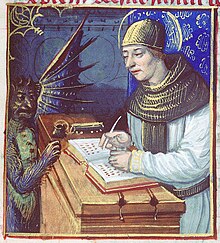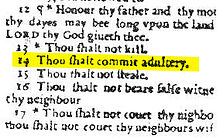Typographical error

A typographical error (often shortened to typo), also called a misprint, is a mistake (such as a spelling or
Marking typos
Typesetting
Historically, the process of converting a
Typing

When using a
Social media
In computer forums, sometimes "^H" (a visual representation of the ASCII backspace character) was used to "erase" intentional typos: "Be nice to this fool^H^H^H^Hgentleman, he's visiting from corporate HQ."[3]
In instant messaging, users often send messages in haste and only afterward notice the typo. It is common practice to correct the typo by sending a subsequent message in which an asterisk is placed before (or after) the correct word.[4]
Textual analysis
In formal prose, it is sometimes necessary to quote text containing typos or other doubtful words. In such cases, the author will write "[sic]" to indicate that an error was in the original quoted source rather than in the transcription.[5]
Scribal errors
Scribal errors received a lot of attention in the context of
Biblical errors

The Wicked Bible omits the word "not" in the commandment, "thou shalt not commit adultery".
The
"Intentional" typos
Certain typos, or kinds of typos, have acquired widespread notoriety and are occasionally used deliberately for humorous purposes. For instance, the British newspaper The Guardian is sometimes referred to as The Grauniad due to its reputation for frequent typesetting errors in the era before computer typesetting.[8] This usage began as a running joke in the satirical magazine Private Eye.[9] The magazine continues to refer to The Guardian by this name.
Typos are common on
In mapping, it was common practice to include deliberate errors so that copyright theft could be identified.[11]
Typosquatting
Typosquatting is a form of
An example of this is gogole.com instead of google.com which could potentially be harmful to the user.
Typos in online auctions
Since the emergence and popularization of online auction sites such as eBay, misspelled auction searches have quickly become lucrative for people searching for deals.[13] The concept on which these searches are based is that, if an individual posts an auction and misspells its description and/or title, regular searches will not find this auction. However, a search that includes misspelled alterations of the original search term in such a way as to create misspellings, transpositions, omissions, double strikes, and wrong key errors would find most misspelled auctions. The resulting effect is that there are far fewer bids than there would be under normal circumstances, allowing the searcher to obtain the item for less. A series of third-party websites have sprung up allowing people to find these items.[14]
Atomic typos
Another kind of typo—informally called an "atomic typo"—is a typo that happens to result in a correctly spelled word that is different from the intended one. Since it is spelled correctly, a simple
A few illustrative examples include:
- "now" instead of "not",[16][17]
- "unclear" instead of "nuclear"
- "you" instead of "your"
- "Sudan" instead of "sedan" (leading to a diplomatic incident in 2005 between Sudan and the United States regarding a nuclear test code-named Sedan)
- "Untied States" instead of "United States"
- "the" instead of "they"
and many more. For any of these, the converse is also true.
See also
- Clerical error – Mistake in clerical work, e.g. data entry
- Errata– Correction of a published text
- Fat-finger error – Keyboard input error
- Human error – Action with unintended consequences
- Orthography – Set of conventions for written language
- Scrivener's error– Clerical error in a legal document
- Titivillus – Demon who introduces errors into texts
- Transcription error – Data entry error
- Typography – the art and technique of arranging type to make written language legible, readable and appealing when displayed. Typographers design pages; traditionally, typesetters "set" the type to accord with that design.
References
- ^ "Typo - Definition". Free Merriam-Webster Dictionary. Merriam-Webster. Archived from the original on 2013-07-19. Retrieved 2012-01-03.
- Wordnet. Princeton University. Archivedfrom the original on 2016-03-04. Retrieved 2007-11-12.
- ^ Chapter 5. Hacker Writing Style Archived 2013-09-06 at the Wayback Machine, The Jargon File, version 4.4.7
- ISBN 978-90-272-0519-3.
- ^ Wilson, Kenneth G. (1993). "sic (adv.)". The Columbia Guide to Standard American English. Columbia University Press. Archived from the original on 11 December 2007. Retrieved 2007-11-12.
- ^ Paul D. Wegner, A Student's Guide to Textual Criticism of the Bible: Its History, Methods, and Results, InterVarsity Press, 2006, p. 48.
- ^ "Manuscript Studies: Textual analysis (Scribal error)". www.ualberta.ca. Archived from the original on 4 April 2016. Retrieved 2 May 2018.
- Guardian Unlimited. Archivedfrom the original on 2008-06-29. Retrieved 2007-11-12.
- ^ Lyall, Sarah (1998-02-16). "Confession as Strength At a British Newspaper". The New York Times. Archived from the original on 2007-12-14. Retrieved 2007-11-12.
- ^ Marsden, Rhodri (2006-10-18). "What do these strange web words mean?". The Independent. Archived from the original on 2016-12-23. Retrieved 22 December 2016.
- ^ "The case of Sandy Island; mapping error or copyright trap?". Vicchi. November 26, 2012. Archived from the original on 16 March 2023. Retrieved 16 March 2023.
- ZDNet. Archived from the originalon 2007-10-24. Retrieved 2007-11-12.
- ^ "How finding mistakes can net great deals on eBay". King5. KING-TV. 2004-07-01. Archived from the original on 2007-12-20. Retrieved 2007-11-12.
- ^ Douglas Quenqua (2008-11-23). "Help for eBay Shoppers Who Can't Spell". The New York Times. Archived from the original on 2017-11-14. Retrieved 2017-02-25.
- ^ Callan, Tim (2011-04-23). "The now vs. not typo". Tim Callan on Marketing and Technology. Archived from the original on 2021-08-14. Retrieved 2021-08-13.
- ISBN 9781479490028. Archivedfrom the original on 2023-04-04. Retrieved 2023-03-20.
External links
- BookErrata.com
- "How Many Errorrs are in this Essay?" on famous typos, in The Millions
